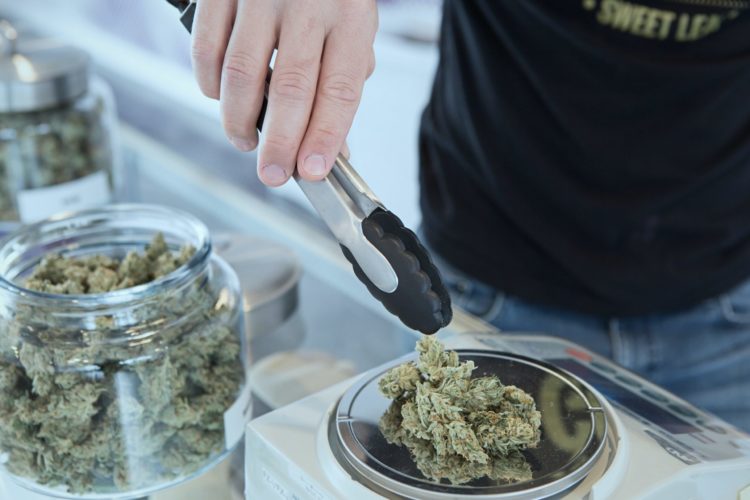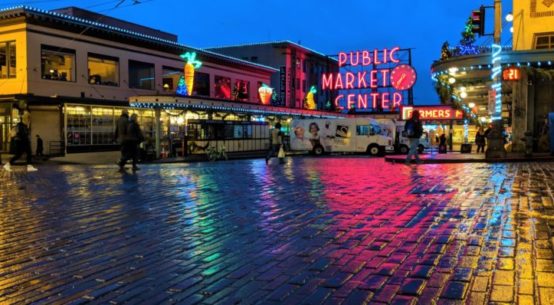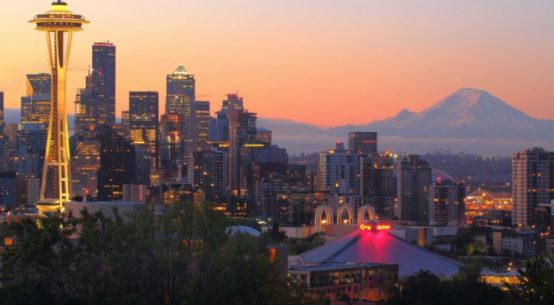
“HEY, EVERYBODY, happy 425! So, uh, yeah, good for you guys!”
The nervous thirtysomething man, dressed in his Papa John’s finery, thrust out a promotional container of cookie dough from the stack he’s struggling to hand out to people in line. “When you’re done, um, you know, come see us, okay? Happy 425!”
“Do you mean, ‘Happy 420?'” I ask.
“Is that what it is? Yeah, okay… Happy 420 times! Make sure you come and see us!”
Jesus Christ.
It’s opening day for Vancouver’s second legal pot store and I’m in line with about 50 others, snaking around a strip mall parking lot on Mill Plain.
Parked police cruisers watch us stand and sweat in the heat. We’re about to find out if this is preferable to the way most of us have obtained cannabis for decades.
Marijuana is legal! Yay!… right?
When Washington State, along with Colorado, passed voter initiatives to make recreational marijuana legal in November 2012, there was a great deal of celebrating.
It was going to be taxed, regulated, and distributed just like liquor! We’d be able to buy weed, hash, pot brownies, and—OHMYFUCKINGGOD, are those pot gummy worms?
Eventually, 334 licenses will be issued by the Washington State Liquor Control Board to operate recreational dispensaries.
As of July 7, they had granted only 25. Operators need to pass a final inspection, and most license holders are not ready for that step. So, unlike Washington’s other substance pusher, Starbucks, you won’t find a dispensary every 50 feet.
Meanwhile, about 30 cities in the state have written and enacted temporary bans for up to one year on recreational dispensaries. Some have removed their bans after setting up new rules, but most have not.
Then there’s supply: Of the more than 2,600 applications submitted by potential pot farmers, about 80 have been licensed.
There’s more than 500,000 square footage of licensed crop presently growing, but most won’t be ready until late July, if then.
And no “special cookies” are to be found, as no processor—meaning, someone who cooks, bakes, or otherwise turns the bud into something other than its raw form—has been issued a license to operate a commercial kitchen, a requirement for making pot-infused edibles.
I first visit Main Street Marijuana in Vancouver, a single-room storefront with a smiling, tie-dye-clad doorman who checks my ID and motions me in.
I count nine customers and six sales staff, all attractive young women. One explains that they have already gone through their first allotment of 10 pounds, and all that remains are two—TWO—packages of “pre-rollies” (pre-rolled cone-style joints).
They are $110 for four grams.
I ask what type of cannabis was used, and get a giggling “You know, I’m really not sure.” The handout from the grower, Farmer J, states: “A combination of small buds and bud trim have been carefully selected to bring you our premium joint.”
Hold the phone.
Small buds and bud trim are typically not used for anything other than making concentrates or edibles. It’s frequently made available by growers for anywhere between $50 and $300 a POUND.
Even with my U.S public school education, these pre-rolls come to a unit price of more than $12,000 a pound.
I walk out wondering if this is the future of legal pot—a mark-up of 4,000 percent on joints.
Back to the sweaty parking lot, where it’s opening day for the only other pot shop in Clark County—New Vansterdam, which is built on the Apple Store model.
I sign a waiver for the documentary they’re shooting, but am sternly told that any photos I take are “illegal”.
I’m given a dry-erase clipboard with my name on it, and enter a huge, long room whose aesthetic can best be described as Genius Bar meets Pac NW—sleek, reclaimed wood forms a long counter that’s filled with tethered iPads, each displaying information about the growers and their products.
The other side of the room is lined with glass cases filled with bongs, pipes, and rolling papers.
The only weed to be seen is locked in white, fist-size sealed plastic containers with a magnifying glass on the top. This allows you to see the weed, but not touch or smell it.
The staff, identically dressed in blue polo shirts, have an informal menu of available strains, containing info on the growers and THC content.
No strains are over 22 percent THC, with some testing at 13 to 16 percent. The budtender agrees that the numbers are a bit low, due in part to the rush to get the product into stores.
I make a selection on my clipboard and an employee runs it back to a second room. I go to pick up my order and pay, but there is confusion—they ring me up for too much, and when the weed arrives, it’s the wrong strain.
It’s packaged in a slick cardboard box, and lists the total THC content at 17.75 percent. I pay $24 for one gram and leave the store to find the line is now three times longer than when I entered 30 minutes ago.
I vape the strain with a friend who grows medical pot in Washington. We agree that the bud is well manicured, but a bit airy in development. The taste is very light, as are the effects.
I’ve had worse, but never at a price of $680 an ounce. “It costs me about $75 to produce an ounce of top shelf,” my friend says. “Not sure this is much of a option for me.”
My trip to Seattle the following day reveals that its only store completely sold out in the first day, and they won’t be restocked for a week or two.
Clearly, it’s not fair to pass final judgment on any businesses during their opening days, and everyone was polite and doing their best under trying circumstances. But the prices, selection, and quality need some improvement before I return.
And before I do, I have to figure out how to submit the receipt for my purchase for reimbursement.
Do we have a line item for weed in the Mercury budget?

